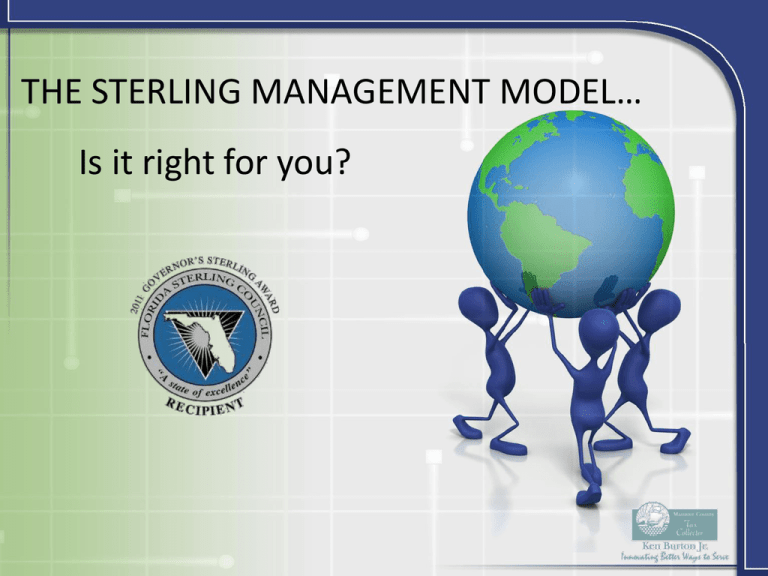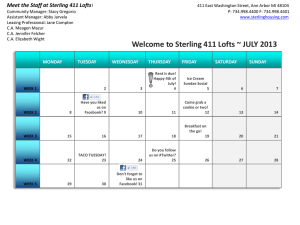Sterling Management
advertisement

THE STERLING MANAGEMENT MODEL… Is it right for you? Objectives • What is the Florida Sterling Council? • Discuss Sterling criteria and the “path” to implementation. • The impact of utilizing the Sterling Management Model…our story and the changes we made! • Is the Sterling Management Model right for you? What is the Florida Sterling Council? The Governor’s Sterling Award and the Sterling Management Model are based on the National Malcolm Baldrige Criteria for Performance Excellence. Established in 1992 the Florida Sterling Council is a public/private not-for-profit corporation supported by the Executive Office of the Governor. It is comprised of public and private sector members. The Council is led by the Executive Committee which oversees the Governor’s Sterling Award for Performance Excellence and all Sterling process activities, including the annual Sterling conference. Sterling Criteria…What is it? The Sterling Criteria includes SEVEN categories: • • • • • • • Leadership Strategic Planning Customer Focus Measurement, Analysis, and Knowledge Management Workforce Focus Process Management/Operations Focus Results The Path for Implementation of the Sterling Management Model The Florida Sterling Council has assessment tools designed to take your organization through various levels of evaluation. At the time of Manatee’s implementation there were THREE unique assessments available to help us prioritize our improvement objectives. The assessments are structured to become more challenging and detailed; the goal is to progressively move your organization toward goals of performance excellence. Sterling Navigator The Sterling Navigator is considered a “developing” level and is a survey-based evaluation. It provides a “snapshot” of where your organization currently is and identifies organizational strengths and key opportunities for improvement. A feedback report is provided with data and by category. It is intended to help your organization’s focus and set future direction. Sterling Challenge The Sterling Challenge is considered a “developing and accelerating” level. This process begins to involve more members of your organization, is more in depth, and your organization receives recommendations as part of an Executive Summary. Governor’s Sterling Award This final step is a comprehensive assessment of the organization by Sterling Examiners. This includes an extensive on-site review and item level feedback of strengths and opportunities to help formulate improvement plans. Organizations that have implemented the Sterling Management Model may be recognized by receiving the Governor’s Sterling Award. Our Story Leadership 2007 Vision, Mission, Values Business hours changed to facilitate training and meetings Standardized Weekly Meetings Senior Team, CC Managers & Home Team Meetings Pass Ups/Pass Downs Monthly Director Days Senior Team Visitation Process Based Leadership Balanced Scorecard Monthly Organizational Performance Reviews 2008 Expectation Reviews Snap-Shot (mid-year) Evaluations 2010 Ethics Training and Signed Ethics Oaths 2012 Systems Access and Business Purposes Use Only Oath 2013 Implemented 2% Identification/Tax Collector Sit-In for Snap-Shot Evaluations. Strategic Planning 2007 Formalized Strategic Planning Process – (Vision, Mission, Values) 2009 SWOT’s for our Vendors/Stakeholders/Employees. 2010 Formalized a 5-Step Strategic Planning Process (Analyze, Approve, Align, Apply, Assess) Key Success Factors/Strategic Objectives (Financial, People, Innovation, Service) Core Competencies/Strategic Advantages (Fast & Convenient Service, Knowledgeable and Cross Trained Staff, Integrating Technologies, Agility) Implemented Environmental Assessment Analysis for better inputs. 2011 Introduced a Calendar of Events for better implementation of the Strategic Planning Process. 2012 Utilized Process Based Leadership to conduct Strategic Planning Meetings. 2013 Completed SWOT for our State, DOR and high level contacts. Customer Focus 2006 Identified three key customer groups (TAX, Motor Vehicle, Government) Checklist Program Introduced 2008 Customer Relationship Management System Implemented Customer Service Requirements (The BUN!) 2009 Voice of the Customer Survey Customer’s provided branch wait times via text messaging and QR (Quick Response) codes. 2011 Implemented Full Service Driver License Operations. 2012 Implemented a System Down Notification process so customers know when systems (FRVIS, FDLIS, etc.) are down in our offices – Facebook, Twitter, www.taxcollector.com 2013 Implemented Automated Appointment Call Back System for our Road Skills Testing customers. Measurement, Analysis and Knowledge Management 2007 Implemented PBL Scorecard software providing electronic scorecards with “stop-light” color-coding for data analysis (Senior Team Level). 2008 Initiated electronic department scorecards to improve alignment. Established user groups and round tables to implement process improvement. 2010 Formalized Performance Improvement Process Model. 2012 Improvement of Scorecard – Better alignment of Key Success Factors to PBL Metrics. 2013 Implementation of Performance Charts. Workforce Focus Employee Engagement Survey Employee SWOT Home Team Recognition Employee of the Quarter Most Valuable Employee of the Year Senior Team Recognition Employee Appreciation Week Longevity Luncheon Degree Pay Mentoring Program Lunch with Tax Collector Casual Days Pass Ups/Pass Downs Security Cameras Badges Deputy on Duty Tax Collector Blog Recognition Communication Between Departments PBL Agenda Item Innovation Proposal Process Essays/Attendance to Sterling Conference Process Management 5 Key Work Process (CC, FC, OP, FS & IT) 3 Key Requirements (Respectful, Timely, Accurate) Identified Key Performance Measure & Goals (2013- reviewed all measures/goals, updated three year projections and ensured all measures still fit within our model.) All align to our Key Success Factors/Strategic Objectives on our Scorecards. Emergency Management Process (Disasters) (2013- Implemented 3 year strategic priority to improve all emergency management functions.) Results Result 7.4-2: Shows the percent of our engaged employees segmented by key workforce group. Engagement levels for all workforce groups have increased over the past three years despite our strategic challenge of compensating employees. Results 7.4-3 Shows responses to each engagement question segmented by key workforce group. Is the Sterling Management Model Right For You? http://www.floridasterling.com






